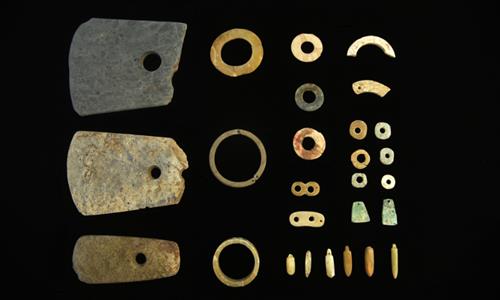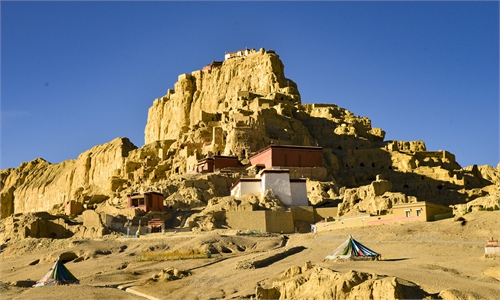ARTS / CULTURE & LEISURE
Top 10 archeological finds unveil evidence of China’s pluralistic unity

A general view of the Mo'er Temple site in Northwest China's Xinjiang Uygur Autonomous Region Photo: Courtesy of the Office of the National Top 10 Archaeological Discoveries Activity
The top 10 Chinese archaeological discoveries of 2024 were unveiled on Thursday in Beijing by the National Cultural Heritage Administration (NCHA).The selected projects are outstanding representatives of work in the field of archaeology over the past year. They cover a wide range of areas, including human origins; the emergence and early development of Chinese civilization; archaeology of the Xia, Shang and Zhou dynasties (c.2070BC-221BC); the formation and development of a unified multi-ethnic nation; and Buddhist archaeology.
These projects have provided further evidence of the prominent characteristics of Chinese civilization — its unity, continuity and inclusiveness, experts told the Global Times.
Huo Wei, a professor at Sichuan University, told the Global Times that the new findings of the discoveries are rich in content and cover a wide geographical range with an emphasis on raising public awareness of archaeology. They demonstrate the integration of multiple disciplines and the application of various technological methods, as well as new developments in archaeological research in the border regions of Xinjiang and Xizang.
One project from each of the 20 provinces or autonomous regions has been shortlisted for evaluation, which was rarely seen in the past. This indicates significant progress in archaeological work in the country. Another point is that many sites have already been or are being developed into archaeological parks in order to help the public better understand the significance of new discoveries, Huo said.
For example, the Mabucuo site in Northwest China's Xizang Autonomous Region and the Mo'er Temple site in Kashi Prefecture, Northwest China's Xinjiang Uygur Autonomous Region provided historical evidence for the formation of the diverse and unified structure of the Chinese nation, Huo noted.
Other discoveries are the Mengxihe Paleolithic site in Southwest China's Sichuan Province, the Xiatang Neolithic site in East China's Zhejiang Province, the Liulihe relic site in Beijing, the Siwa site in Northwest China's Gansu Province, the Panlongcheng site in Central China's Hubei Province, the Zhouyuan site in Northwest China's Shaanxi Province, the Wuwangdun No.1 tomb in East China's Anhui Province, and the Hebosuo site in Southwest China's Yunnan Province, according to the NCHA.
The top 10 discoveries are selected from 30 finalists through an open ballot conducted by 21 leading scholars from the nation's top archaeological institutes and universities.
Massive challenges
The new discoveries at the Mabucuo site represent the most significant academic breakthrough in Neolithic archaeology in Xizang in recent years.
The site has revealed the highest-altitude, earliest-dated, longest-lasting (from 4,800 years to 2,000 years ago), and most clearly defined cultural sequence found to date in the heart of the Qinghai-Xizang Plateau.
It fills a critical gap in the study of human survival strategies during the Neolithic period at high altitudes and provides the richest collection of data so far for research on Neolithic settlements and social development in Xizang.
This site is likely the most challenging among the shortlisted projects in terms of archaeological work, due to its altitude of over 4,000 meters.
It holds great value for understanding human activity in the region, especially the transition from a fishing and hunting lifestyle to the eventual development of agriculture, Chen Xingcan, director of the Institute of Archaeology under the Chinese Academy of Social Sciences, told the Global Times.
Xiage Wangdui, head of the Mabucuo archaeological project, told the Global Times that the lack of oxygen on the plateau and extreme weather fluctuations greatly increased the difficulty of on-site excavation. Every member of the archaeological team has endured both physical and psychological challenges. After five years of hard work, their efforts were richly rewarded with significant findings, he noted.
The Mo'er Temple in Xinjiang is a Buddhist temple site dating back from the Eastern Han Dynasty (25-220) to the Tang Dynasty (618-907).
It offers valuable insights into how Buddhist temples spread from South Asia into China, and serves as a case study for understanding the localization of Buddhist culture within the Chinese context, Chen said.

Porcelains excavated from Mabucuo site in the Xizang Autonomous Region Photo: Courtesy of the Office of the National Top 10 Archaeological Discoveries Activity
Filling the gapAnother highlight of the new discoveries is that four projects featuring Xia, Shang and Zhou findings all made it to the shortlist.
In March, the NCHA announced the launch of the Xia and Shang civilization research project. It will bring together domestic research institutions and universities to work on constructing a comprehensive archaeological and historical framework for the Xia and Shang dynasties.
Lei Xingshan, president of the Beijing Union University, told the Global Times that the project is necessary to fill historical gaps regarding the state and civilizational forms of the Xia and Shang dynasties, and to provide richer and more concrete evidence in response to foreign doubts about the existence of the Xia Dynasty.
The Panlongcheng site was a central urban settlement in the middle reaches of the Yangtze River during the Xia and Shang periods, and is a key site for exploring the development of early civilization in the Yangtze River basin.
Recent discoveries reveal the site's phased urban transformation, shedding light on the southern expansion of the Central Plains dynasties. For the first time, archaeological evidence has clarified the trend of water level changes in the middle Yangtze River during the Xia and Shang periods.



